In response to popular demand, we’ve scaled it up a notch and have taken the 5.56 muzzle brake testing to 7.62. Specifically, 24 muzzle devices threaded 5/8-24 for use with .30 caliber cartridges joined in the fun, all of them getting tested for recoil reduction prowess on a .308. Come on in, the water’s just fine . . .
https://www.youtube.com/watch?v=0qDf6Xf0rR4
The procedure for this .308 test was basically identical to the 5.56 muzzle brake tests. You can find the first one here, the second one there, and the third one over here. For the Operators out there, we got a sweet Lux meter and tested the muzzle signature reduction effectiveness of flash hiders and other muzzle devices as well. Flash hiding test #1 is here, and #2 here. You may also be interested in the AR-15 Drop-In Trigger Roundup here.
These tests are expensive, but I’d love to do more. I’ve purchased air pressure sensors designed to log blast waves so we can compare the amount of concussion each muzzle device generates, and these will be used in test four. But I have a lot of brakes to round up for that and the funding is low. I also want to do another AR-15 trigger roundup (component triggers this time) and a couple of flashlight roundups (tactical and gun-mounted). Please consider supporting this sort of testing via my Patreon page. As a Patron you can also get free stuff, join live streams, gain early access, and more.
This test was made possible with the assistance of a few sponsors:
- Lancer Systems loaned me an L30 Heavy Metal rifle to use as the test bed. It’s an AR-10/SR-25 pattern gun, and it’s dang nice. I’m hanging onto it for a while longer, and after some accuracy testing and a few hundred more rounds I’ll follow up with a review on it. That said, I’ve shot Lancer’s .308s out to 1,000 yards before and have had this carbon fiber beast out to the woods with me a few times since December, and it’s going great.
- Gorilla Ammunition provided the ammo for this test. The way the test works, loading inconsistency in ammo will directly skew the results. Knowing that precisely-loaded, consistent, repeatable ammunition was critical, I reached out to Gorilla and was thrilled when they agreed to send me enough of their 175 grain Sierra MatchKing .308 loads to perform this test with some to spare. It’s among the most consistent ammo on the market.
- My local indoor range and one of my go-to FFLs, Sharp Shooting Indoor Range & Gun Shop, was kind enough to shut down their South bay for me so I could perform the test there. Originally the test was going to happen in early November, but has been weather-delayed since then. With no end to that in sight, Sharp Shooting saved my hide and put a roof over my head. Doing it indoors also helps with consistency thanks to a constant temperature, humidity, flat ground, etc. Frankly, I’d like to do the next 5.56 test and other stuff there, too, but it’s a big ask since they have to shut down half their range for a couple hours. Next time you’re in the market for firearms, NFA goods, optics, gun-related gear, etc, give Jeremy Ball or Nick Brown there a call (509.535.4444) and tell ’em I sent you. They’re one of the country’s largest stocking dealers for Primary Weapons Systems — anything PWS ships free — but they carry just about everything you can think of (including Lancer Systems and Gorilla Ammo, actually).
Recoil Testing
We’ll keep the test procedure description quick. For more info, refer to the video above and/or the 5.56 muzzle brake tests.
- The L30 Heavy Metal was strapped to the test rig, which was free to slide on a plastic table. I measured how far the rig slid back for each shot. This is one method of quantifying rearwards recoil energy. Bare muzzle is the basis for comparison against which all of the muzzle devices are measured.
- Only a single round of Gorilla .308 was loaded for each shot (one in the chamber, zero in the mag).
- The rifle’s Syrac Ordnance gas block was turned off. This means the action did not cycle — the bolt remained locked in battery — and each round was manually ejected before loading the next.
- Each muzzle device was timed properly, and tested twice.
- Recoil distance was measured in 1/16″ increments. All of the data here has been converted from that to decimals.
As simple and as “redneck” as this test looks — and is, sure — the average difference between the shortest slide and the farthest slide for all 25 tests (24 muzzle devices plus bare muzzle) was 0.1425″. Barely over an eighth of an inch. It’s crazy consistent.
So, who won? Well… .308 may not be 5.56, but a good design is a good design…
Precision Armament’s M4-72 Severe-Duty Compensator!
Yeah, no kidding. I’ve now thrown 95 different muzzle devices at it, and it’s still reigning supreme. In two calibers. In a design that’s shorter, narrower, lighter, and less expensive than a lot of its competitors. Respect.
On the .308, the M4-72 reduced recoil by 64.43% from a bare muzzle. In 5.56, that figure was 73.84% in test one and 73.5% in test two. This discrepancy is not unexpected, as the larger bore diameter on these .30 caliber devices means the baffles will allow more gas through.
This is also the primary reason why .45 ACP suppressors are almost always louder than 9mm suppressors. Just to put it in perspective, if the 5.56 brakes have a bore diameter of 0.244″ and the .30 cal brakes have a bore diameter of 0.328″ (using a fairly standard 0.020″ overbore), then the surface area of a .30 cal bore hole is a whopping 81% larger.
Note: there is no comparison whatsoever between the inch measurements in this test and those in the 5.56 tests. The weight of the test rig was completely different. Really, the inch measurements in any of these tests are random and arbitrary anyway. The key stat is the recoil reduction as a percentage.
Recoil test results for all of the entrants can be seen in the graphs and tables below. Click on any of the images in this article to see them full-size. Additionally, all of the raw data can be downloaded in an Excel doc by clicking here.
The following numbers don’t have any real meaning by themselves at all, it’s just an invented index so we can rank all of the muzzle devices in this test by how much relative recoil reduction you get per dollar of cost. A higher number — meaning most performance per dollar — is better:
Recoil reduction performance in chart form:
All the hard stats in chart form:
Muzzle Brakes / Compensators
Listed alphabetically. All stated weights and dimensions are as measured by me. I noted obvious errors on many manufacturers’ sites so chose not to use any of their info across the board.
AAC BRAKEOUT:
This is an old design and has been replaced by the BRAKEOUT 2.0. I included it anyway since I had it and since I’m sure plenty of people own them and may be curious. Please send all complaints to Nick.
Machining is great and finish is good. As with most of the muzzle devices that act as a QD mount for a suppressor, you’re getting extra material and weight that you don’t need unless you own the applicable can, and you’re paying for that machining complication as well. The BRAKEOUT is supposed to be a best-of-both-worlds sort of a thing but, frankly, I’m not a big fan of the design. It’s a below average muzzle brake yet still has brake-like concussion (less so in v2.0), and it’s a poor flash hider (as seen here).
Click here to jump to its point in the video.
Material: Steel
Finish: Not Specified
Length: 2.568″
Diameter (at largest point): 1.136″
Weight: 3.603 oz
MSRP: $124.99
Dead Air Armament Keymount Muzzle Brake:
Dead Air’s Keymount Brake is another suppressor QD mount. Like the BRAKEOUT, that means extra metal that serves no function unless you own a Dead Air Sandman. Unlike the BRAKEOUT, it’s a full-on muzzle brake and compensator and placed about middle of the pack on recoil reduction (and doesn’t break the bank).
The one photographed above is a well-used sample that I borrowed for this test. I also have a brand new, 5.56 one for the next AR-15 test and the quality of the machining is really excellent. The finish is great, too, but put a can over the top and fire a few hundred rounds and you’ll nail that “experienced” patina seen above.
Click here to jump to its point in the video.
Material: Steel
Finish: Not Specified
Length: 2.602″
Diameter (at largest point): 1.082″
Weight: 3.638 oz
MSRP: $89
Dead Air Armament Sandman Ti:
Sharp Shooting has my Sandman Ti in NFA purgatory, but since they have a range on-site I’m able to borrow — staying on the premises — and shoot any NFA items of mine that are awaiting Form 4 approval. Takes a bit of the edge off the tax stamp wait.
At any rate, a .30 caliber suppressor has been missing from my silencer cache and the Sandman Ti was my choice. Dead Air’s QD mount system is awesome, but I wanted a direct-thread can for a handful of reasons. A full review on this bad boy will come eventually, but for now I’ll just say that the machining is perfect and there are no flaws in the Cerakote application. It was, without a question, by far the most pleasant .308 muzzle device to shoot at an indoor range. Blast and concussion? None.
Click here to jump to its point in the video.
Material: Titanium tube, Stellite baffle core
Finish: Cerakote
Length: 8.2″
Diameter (at largest point): 1.5″
Weight: 16.8 oz
MSRP: $849
Dynamic Resistance Muzzle Brake:
The .30 cal brake from Dynamic Resistance followed the Dead Air brake alphabetically and exactly matched its recoil reduction performance. It’s a clean looking, compact brake and compensator at a competitive price. I like the look of the curved baffles when viewed from the side.
Machining is completely clean. Parkerized finish is standard.
Click here to jump to its point in the video.
Material: 4140 Steel
Finish: Mil-Spec Parkerize
Length: 2.104″
Diameter (at largest point): 1.001″
Weight: 3.06 oz
MSRP: $75
JP Rifles Large-Profile Compensator:
Right in the middle of the pack on recoil reduction is the JP Comp. As you’d expect from JP, materials and machining are top notch. These comps come in all sorts of base diameters, bore diameters, and in either stainless or black finishes to suit most any rifle. They’re a popular sight on competition guns.
Click here to jump to its point in the video.
Material: Stainless Steel or Carbon Steel
Finish: Machined Stainless or Matte Black
Length: 2.752″
Diameter (at largest point): 1.221″
Weight: 5.432 oz
MSRP: $99.95
Knight’s Armament Company 762MAMS Muzzle Brake:
The MAMS — Multi-Axis Muzzle Stability — brake works as a QD mount for KAC’s QDC suppressors and also as a standalone muzzle device. It’s well made, albeit large and fairly complex. It’s also four hundred freakin’ dollars.
Near bottom of the pack here for recoil reduction, but it’s another combo device rather than a brake with big baffles. As such, it does have less concussion than basically any of the true brakes.
Click here to jump to its point in the video.
Material: Steel
Finish: Not Specified
Length: 3.293″
Diameter (at largest point): 1.142″
Weight: 5.185 oz
MSRP: $399.95
Kahntrol Solutions 3-Gun Muzzle Brake:
I can see Kahntrol Solutions’ hexagonal muzzle brakes working pretty well aesthetically with certain rifle builds. I’m guessing they’re buying cold rolled steel hex rod and having at it. Leaving the flats unmolested and using a treatment like black oxide rather than a coating (e.g. Cerakote) does result in a slightly porous looking surface with little pock marks in the metal. Not that one’s face is generally close enough to a muzzle brake to notice.
Solid performance, unique aesthetics.
Click here to jump to its point in the video.
Material: 4140 Steel
Finish: Black Oxide
Length: 2.6″
Diameter (at largest point): 0.988″
Weight: 3.03 oz
MSRP: $94.95
Kahntrol Solutions HexMod Brake:
The 3-Gun above is sized to be legal for 3-Gun and other competition use. The HexMod is more of an “open” brake — basically the same design, but in a larger diameter. Although larger baffles would typically mean more recoil reduction performance, Kahntrol states on its website that in .308 and smaller calibers, the HexMod and 3-Gun perform pretty much identically. I had a hard time believing that would really be the case, but, indeed, the HexMod cut recoil by only half of one percent more than the 3-gun did. Apparently, the HexMod comes into its own when you crank up the volume beyond .308.
Again, Kahntrol’s machining is clean, but the bar stock has some surface roughness to it that remains visible. The black oxide treatment on both brakes is even and looks good.
Click here to jump to its point in the video.
Material: 4140 Steel
Finish: Black Oxide
Length: 2.613″
Diameter (at largest point): 1.29″
Weight: 5.009 oz
MSRP: $99.95
Lancer Systems Nitrous Compensator:
The Nitrous comes installed from the factory on the Lancer L30 Heavy Metal rifle used for this test. Ahead of the ports is an enclosed blast chamber, and on the top of that blast chamber is a pair of holes. These holes vent gas upwards to combat muzzle rise. What makes the Nitrous unique, though, is that these holes are threaded, and the comp ships with 6 set screw “jets” allowing the end user to custom-tune downward force. Choose from any combination of no jets, two large aperture jets, two small aperture jets, and two solid plugs to get it just right.
It proved to be a bit more competitive in 5.56 than in this circle of .308 brakes, but it’s still a great looking muzzle device with flawless machining and finish and adjustable muzzle rise compensation to boot.
Click here to jump to its point in the video.
Material: Steel or Stainless Steel
Finish: Black Nitride or Bead Blast Stainless
Length: 2.876″
Diameter (at largest point): 0.997″
Weight: 4.797 oz
MSRP: $90.05
Lancer Systems Viper Brake:
Ask Lancer to throw out size and weight considerations and come up with something that’s as effective as possible, and they’ll show you the Viper — our 3rd place finisher. Like the Nitrous, it has adjustable jets for tuning muzzle rise, but on the Viper they can also be used to tune for muzzle drift (push the muzzle left or right). Shaped a bit like the head of a pit viper, it’s a 3-chambered brake with rearwards-angled blast baffles.
Once again, machining and finish are top notch. For the shooter, this brake sounds and feels like most of the others. For those around you, it gives a heck of a thump. It can be tuned very effectively for shooting from a bipod or offhand, for left- or right-handed shooters. It’s available in two finishes and for 6.5 or .30 calibers.
Click here to jump to its point in the video.
Material: Steel or Stainless Steel
Finish: Black Nitride or Machined Stainless Steel
Length: 3.772″
Diameter (at largest point): 1.877″
Weight: 10.229 oz
MSRP: $169.99
Lilja Precision Rifle Barrels Heartbraker:
Lilja’s Heartbrake is so named for its heart-ish-shaped ports. Somewhat like the Thunder Technologies brakes in 5.56 test #2, actually. This baffle/port design certainly seems effective, as all of these brakes cut recoil more than I would have expected given their relatively small diameters and port sizes. It’s lighter on concussion and blast than most, too.
The straight-walled Heartbrake is designed to appear like barrel, and is offered in a couple diameter options to help make that happen. The 0.875″ one seen here was an exact match for the L30 Heavy Metal’s stainless barrel. It’s a really nice, precision piece.
Click here to jump to its point in the video.
Material: Stainless Steel
Finish: Machined Stainless Steel
Length: 3″
Diameter (at largest point): 0.875″
Weight: 4.056 oz
MSRP: $95
Nord-Arms Muzzle Brake OPEN 308 Caliber:
Nord Arms is located in Estonia, and their parts will be available in the U.S. very soon. They were kind enough to mail me their OPEN brake for .308, their OPEN and STANDARD brakes for 5.56, and one of their drop-in trigger units to include in my upcoming AR-15 drop-in trigger roundup. The wife promptly absconded with the Estonian postage stamps for her journal/scrap book thing.
Anyway, all of these brakes are available in 4140 steel or in Titanium. My steel examples are machined to an average degree of precision with a bit of roughness around the edges and some internal tool marks still visible. U.S. production versions will be nitrided, resulting in a deeper, more even finish, but mine are black oxide or parkerized. Clearly, this OPEN brake is massive, looking like it belongs on a .50 cal or maybe a Howitzer — it has the whole arrowhead shape, reverse-venting thing going on. Instead of shimming or using a crush washer to time it, the brake can simply be clamped down with the two included bolts.
Click here to jump to its point in the video.
Material: 4140 Steel or Titanium
Finish: QPQ Nitride (my non-U.S. model is black oxide or parkerized)
Length: 2.661″
Diameter (at largest point): 1.58″
Weight: 8.113 oz
MSRP: Not yet available for purchase in the U.S., but likely about $75 when Nord-Arms parts hit our shores soon
Precision Armament EFAB Hybrid Muzzle Brake:
The EFAB is another all-around muzzle device, designed to work as a brake (recoil reduction), compensator (muzzle movement — particularly rise — reduction), and flash hider (self explanatory). This design happens to be pretty darn good at all of those things. It’s also noticeably milder on blast and concussion than any baffled brake in this test.
As I’ve come to expect from Precision Armament, the machining is as clean as it gets and the materials and finish are excellent.
Click here to jump to its point in the video.
Material: HTSR 416 Stainless Steel Bar
Finish: Ionbond CrCN Matte Black
Length: 2.743″
Diameter (at largest point): 0.986″
Weight: 4.374 oz
MSRP: $169.95
Precision Armament M11 Severe-Duty Muzzle Brake:
Again, machining and finish on the M11 is as good as you’ll find. It’s a large and aggressive-looking brake that’s at home on a precision rifle or maybe something a little louder like my Mosin Nagant:
It’s also effective, and nailed a solid 4th place finish here.
Click here to jump to its point in the video.
Material: HTSR 416 Stainless Steel Bar
Finish: DLC Matte Black or Bead Blast Stainless
Length: 2.668″
Diameter (at largest point): 1.366″
Weight: 5.538 oz
MSRP: $119.99
Precision Armament M4-72 Severe-Duty Compensator:
No doubt about it, Precision Armament came up with a gem in the design of the M4-72. As mentioned earlier, across both 5.56 and .308 it has remained the recoil reduction champion against 95 other muzzle devices. Rearwards-angled baffles are definitely a key design feature — although not one that’s unique to the M4-72 — but I otherwise can’t explain why this thing keeps beating out competition that’s significantly larger, heavier, more concussive, more expensive, etc.
Click here to jump to its point in the video.
Material: HTSR 416 Stainless Steel Bar
Finish: Ionbond CrCN Matte Black or Bead Blast Stainless
Length: 2.278″
Diameter (at largest point): 0.986″
Weight: 3.2 oz
MSRP: $99.99
Precision Firearms LMD Large Diameter Brake:
Once again, Precision Firearms’ LMD has surprised me with great recoil reduction performance out of a small, aesthetically-clean package. Like Precision Armament, Precision Firearms’ workmanship is aces. Maybe the trick is putting “precision” in your name?
This is the LMD Large, but PF also makes an LMD Small with a smaller diameter. They’re also available in four different finishes.
Click here to jump to its point in the video.
Material: 416 Stainless Steel
Finish: Black Nitride as tested (also available in Cerakote, machined stainless, or bead blast stainless)
Length: 2.035″
Diameter (at largest point): 1.102″
Weight: 3.95 oz
MSRP: $95 as tested (from $85 to $105 depending on finish choice)
Primary Weapons Systems PRC (Precision Rifle Compensator):
PWS’s PRC looks like it has a bunch of baffles but actually has just one — bored to handle up to .338 caliber — at the muzzle. It’s wide open through the rest of it, which may explain its low level of concussion. Of course, it probably also explains why it placed in the bottom 1/3 of these muzzle devices on recoil reduction. Not that cutting recoil by exactly 50% vs. a bare muzzle is anything to sneeze at! There was some tough competition here. If you’re shopping for muzzle stability, low concussion, low dust kick-up, and kicking half of your .308’s recoil to the curb, plus like the PRC’s looks, it could be a solid choice.
Details on build are not available on the PWS website. It’s obviously steel, but I’m not sure what the rough-textured coating is. It’s kind of cool in that it’s a very matte finish and seems kind of thick and feels like fine sandpaper, but it does show scuffs and such pretty readily.
Click here to jump to its point in the video.
Material: Steel
Finish: Not Specified
Length: 3.003″
Diameter (at largest point): 1.102″
Weight: 5.079 oz
MSRP: $99.95
Seekins Precision AR ATC (Advanced Tactical Compensator):
Seekins Precision has built a reputation on, well, precision machining and their ATC is no exception. Despite a design that involves 90° edges in many places, everything is crisp, clean, and burr- and tool mark-free. I’d actually be quite curious to test an ATC that didn’t have the linear holes drilled through all of the baffles to see what sorts of differences that would make. Obviously it’s lighter for that additional air space and maybe has less concussion, but I wonder if it might jump up a few percentage points in recoil reduction with solid baffles. Still, it placed solidly in the top half here and it’s relatively lightweight and narrow.
Click here to jump to its point in the video.
Material: 416R Stainless Steel
Finish: Bead Blasted Stainless or Black Melonite
Length: 2.432″
Diameter (at largest point): 0.953″
Weight: 3.122 oz
MSRP: $89
SIG SAUER Micro-Brake:
SIG’s QD mount for its suppressor line allows the very front part of it to be swapped out quickly and easily without removing the mount from the rifle:
That’s actually the “Micro-Brake” part, but since the entire thing is required for it to function I’ve measured it as a complete unit for the purposes of the stats below. A flash hider, larger brake, and other options are available or will be soon. Can a “micro,” single-chamber brake like this actually do anything? As it turns out, yes, it can and does. The Micro-Brake served to reduce recoil by 44.85%.
Click here to jump to its point in the video.
Material: Steel
Finish: Not Specified
Length: 1.511″ (including mount)
Diameter (at largest point): 1.198″ (including mount)
Weight: 2.946 oz (including mount)
MSRP: $69
SkyArms .308 Muzzle Brake:
This is one of the more compact brakes in the test, and I had high hopes for its recoil reduction prowess based on its rearwards-venting ports. It didn’t quite live up to my guesstimate of how it would perform, but it still cut recoil by over half and was only beat out by one other brake that’s legitimately smaller than it (but also costs almost twice as much). I like the SkyArms Brake’s looks — kind of a shark gills thing going on — plus it has clean machining and a rough, matte finish similar to PWS’. That finish, I believe, explains the seemingly random extra thousandths of an inch on the length and width measurements.
Click here to jump to its point in the video.
Material: 4140 Steel
Finish: Black Matte
Length: 2.001″
Diameter (at largest point): 1.001″
Weight: 2.967 oz
MSRP: $69.95
SureFire PROCOMP 762:
The PROCOMP is the performance-per-dollar winner, cutting recoil by 53% with an MSRP of just $59. Despite this, it’s flawlessly machined and the melonite finish is deep and even. SureFire also makes versions of this brake with QD mount functionality for their various suppressor lines. If you don’t own a SureFire can, this is the PROCOMP you’d want. If you do own a SureFire can, obviously go with the QD version that fits your suppressor, and know that its function on its own as a brake will be identical to this one.
Click here to jump to its point in the video.
Material: Steel Bar Stock
Finish: Black Melonite
Length: 2.712″
Diameter (at largest point): 0.868″
Weight: 3.19″
MSRP: $59
Thunder Beast Arms Corporation 30CB Brake:
TBAC is well-known for strong, quiet, and lightweight suppressors, and it looks like they’re nailing the light-yet-effective thing when it comes to muzzle devices as well. Their flash hider showed its skills in flash hiding test #2, and the 30CB Brake seen above definitely punches out of its weight class. Two, rearwards-angled baffles are responsible for its surprising recoil reduction given their diminutive diameter.
Frankly, the machining and finish on TBAC’s muzzle devices is so freaking good that it made me wonder if I made the right .30 cal suppressor choice. Eventually I’ll shoot my Dead Air next to Tyler’s Thunder Beast and we’ll see where the chips fall. And again, the machining and finish on the Dead Air brakes is A-List all the way, but these TBAC units just take it to the next level. I’m not saying it’s alien technology…but…
Click here to jump to its point in the video.
Material: Steel
Finish: Ionbond DLC
Length: 1.709″
Diameter (at largest point): 1.062″
Weight: 2.103 oz
MSRP: $125
Thunder Beast Arms Corporation CB Series Flash Hider:
…it’s probably alien technology. This is the .30 cal version of the CB Flash Hider seen in flash hiding test #2. Looks like the way the prongs come together a little bit towards the muzzle provides some recoil reducing gas redirection, as it took over 17% of the punch out of the bare muzzle.
Click here to jump to its point in the video.
Material: Steel
Finish: Ionbond DLC
Length: 2.316″
Diameter (at largest point): 1.062″
Weight: 3.116″
MSRP: $125
VooDoo Innovations Jet Comp .30 Cal:
VooDoo Innovations is sort of like the aftermarket parts division of Adams Arms, making not only AR-15 parts but parts for Glocks and other rifles and pistols. Their Jet Comp is a 3-port brake with muzzle rise-compensating ports on top. It’s a simple, clean design and it’s also extremely effective, taking 6th place here. Solid “A” for machining and finish. VooDoo’s “LifeCoat” finish can actually refer to a handful of different processes, but in this case I believe it’s a PVD nitriding of some flavor.
Click here to jump to its point in the video.
Material: Steel
Finish: LifeCoat
Length: 2.312″
Diameter (at largest point): 0.941″
Weight: 3.109 oz
MSRP: $89.18
Final Thoughts
The top 10 brakes in this test placed within 10% of each other — from ~64% recoil reduction to 54% recoil reduction. The vast majority reduced recoil by half (50%) or more. Really, this was a good crowd and they’re all very effective. Can you tell the difference between a 54% reduction and a 64% reduction? I’m going to do some blind taste tests to try and answer that objectively.
But if you’re looking to reduce recoil as much as physically possible and keep that muzzle rock steady, Precision Armament’s M4-72 continues to prove itself and has now defended its title against 95 contenders across two calibers.


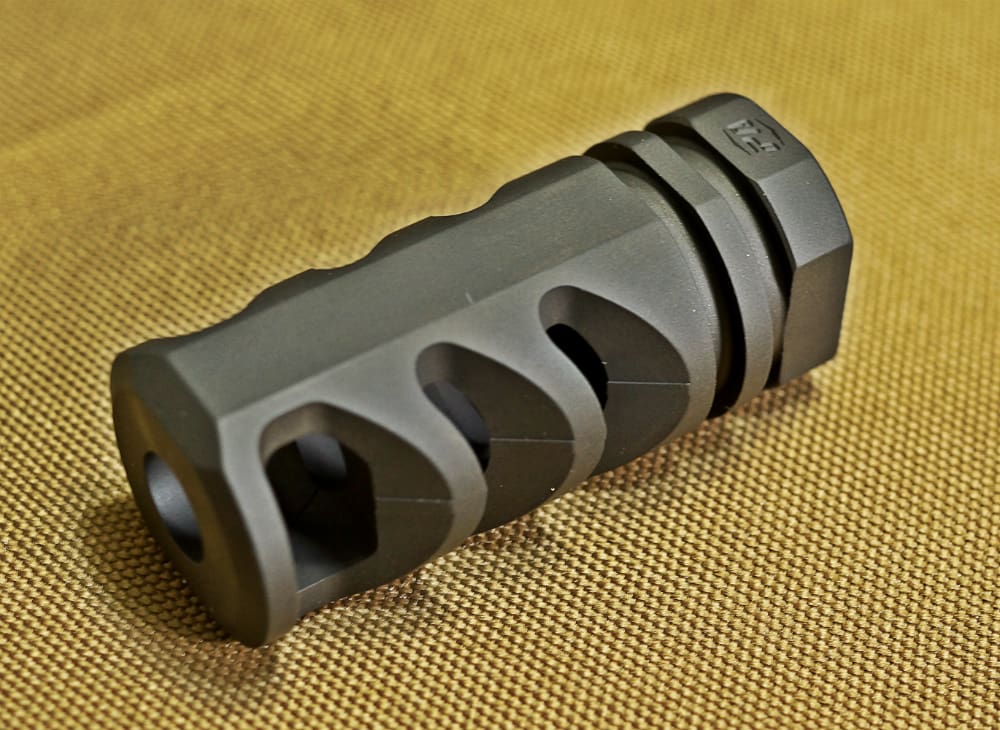
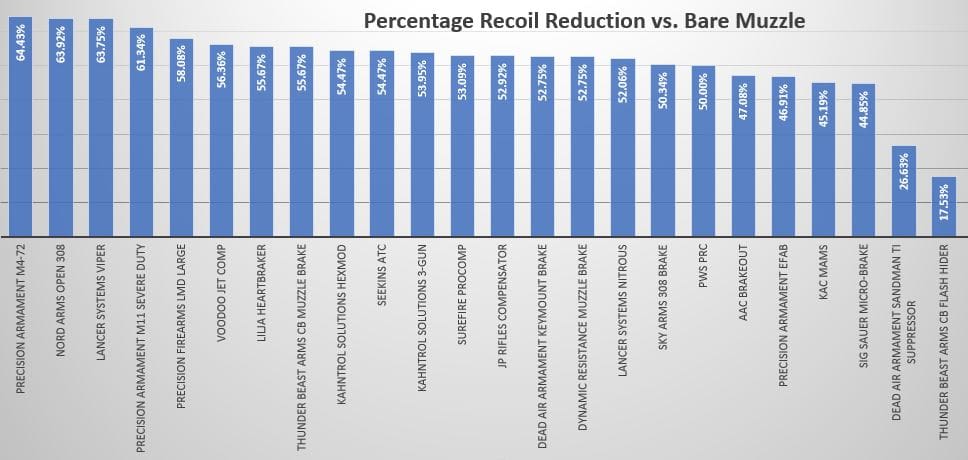
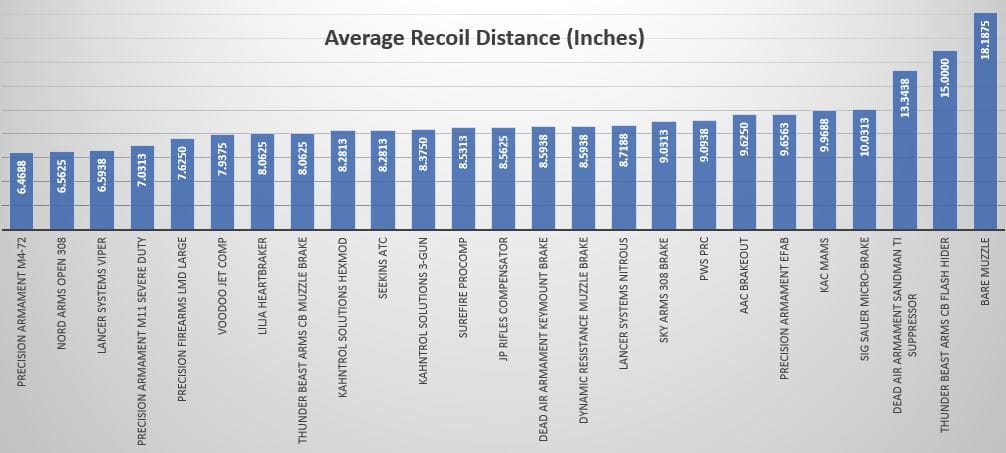
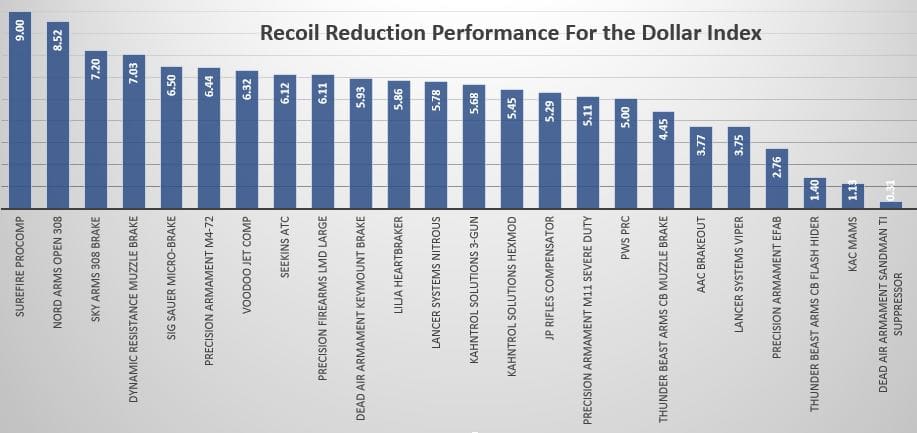

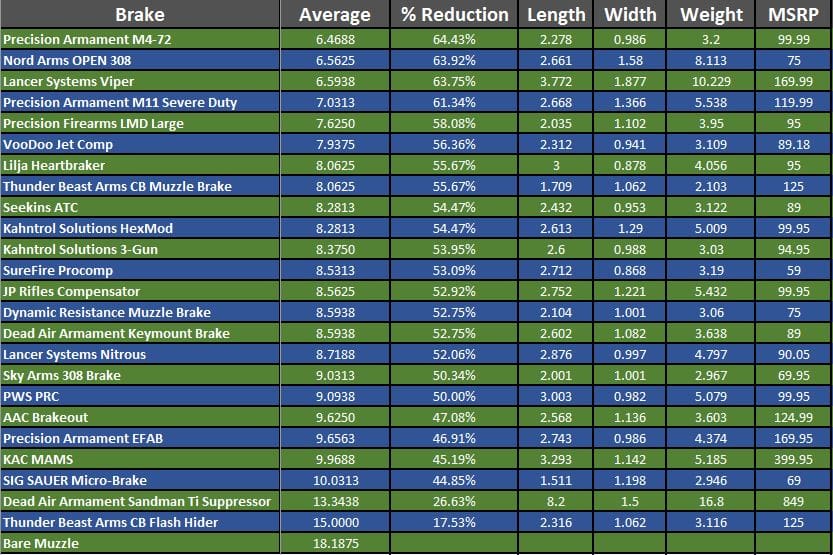
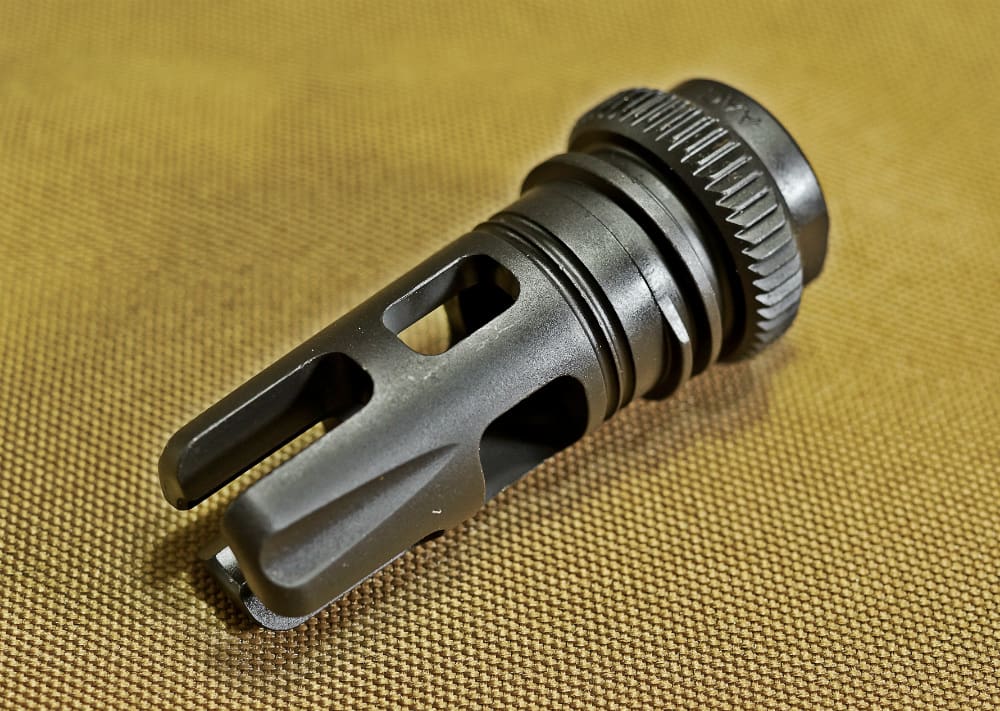
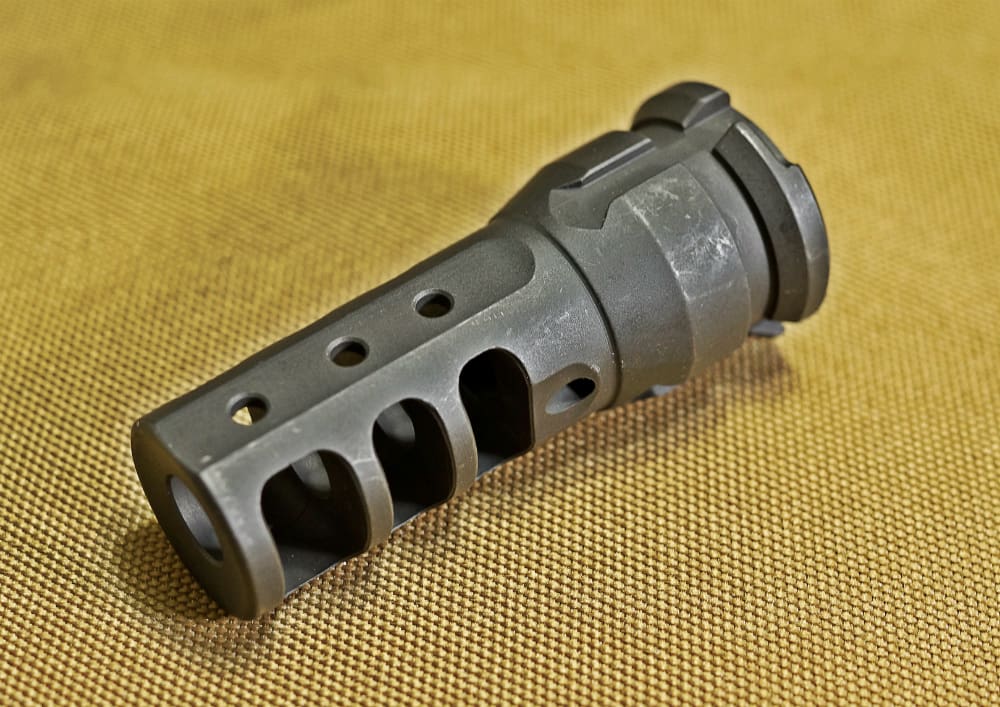

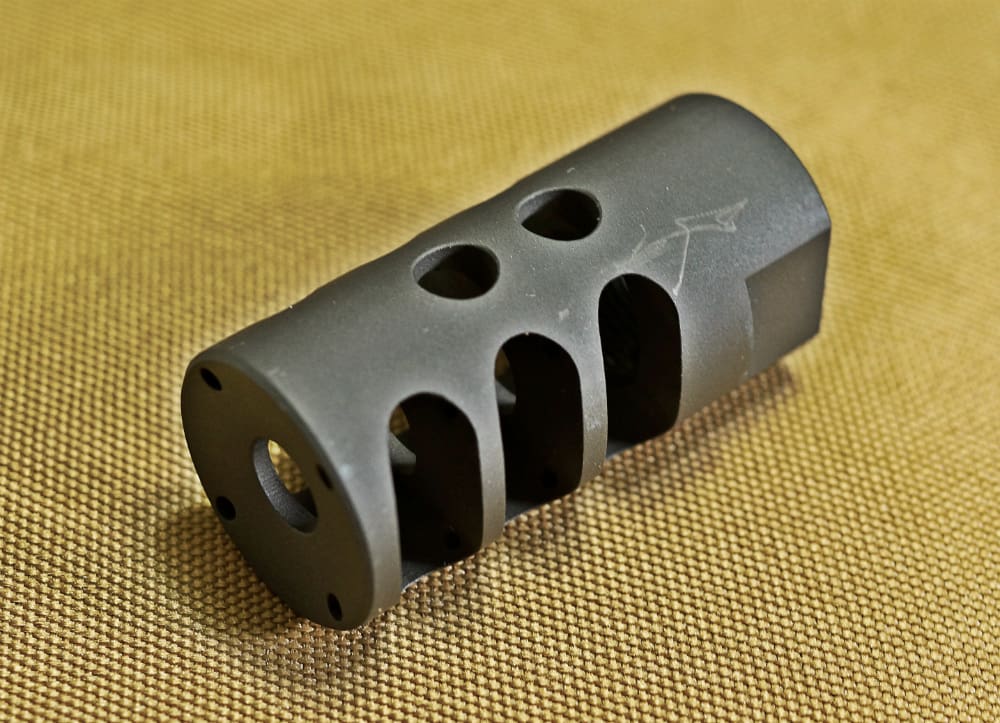
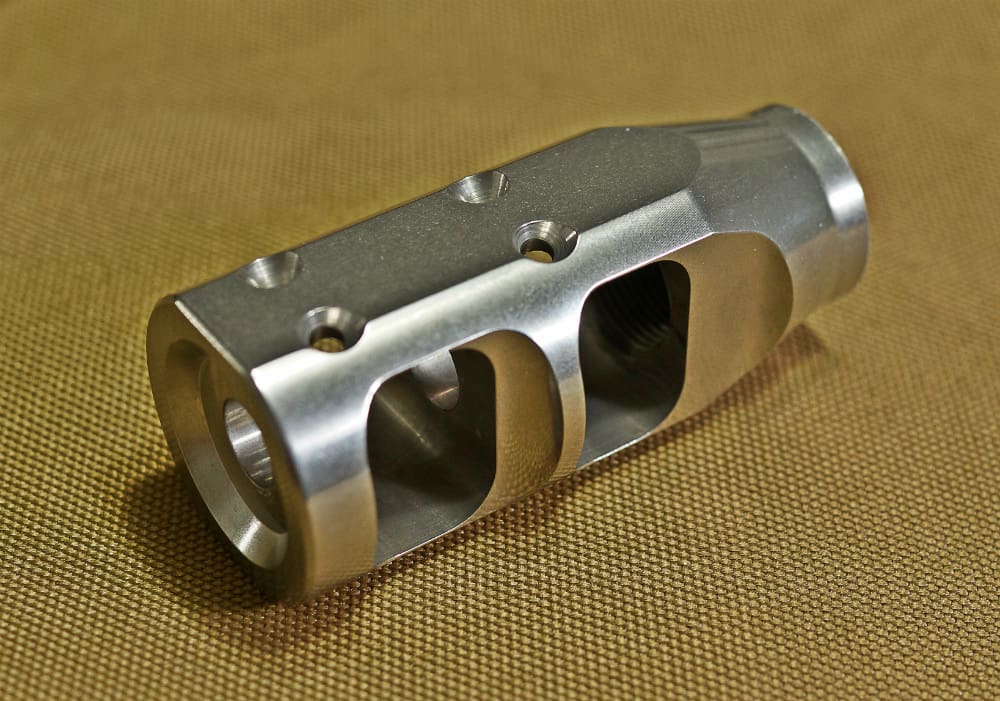
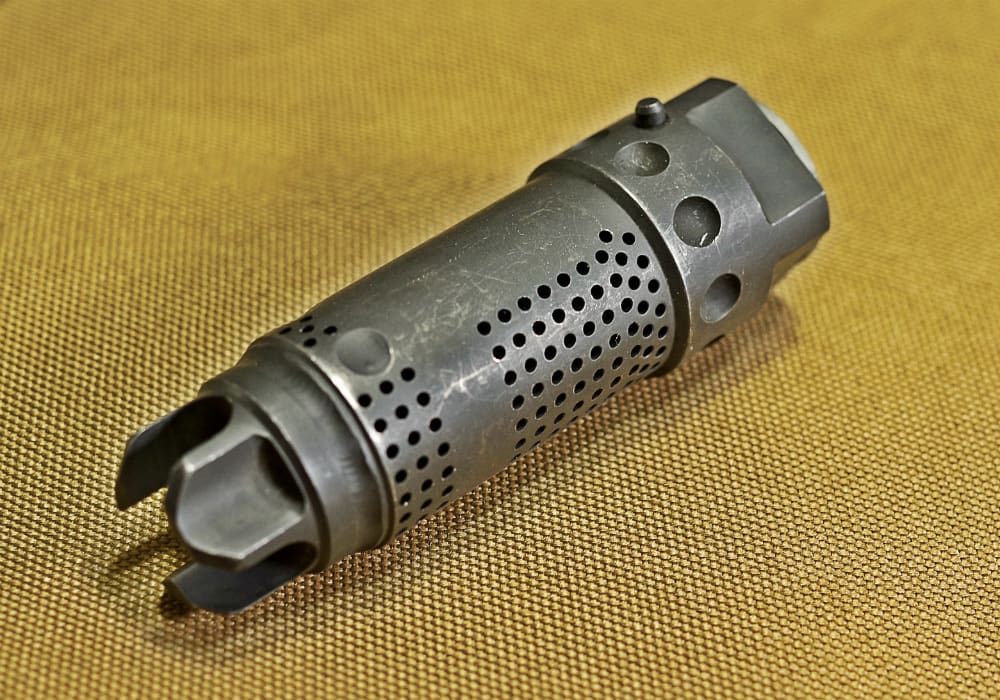

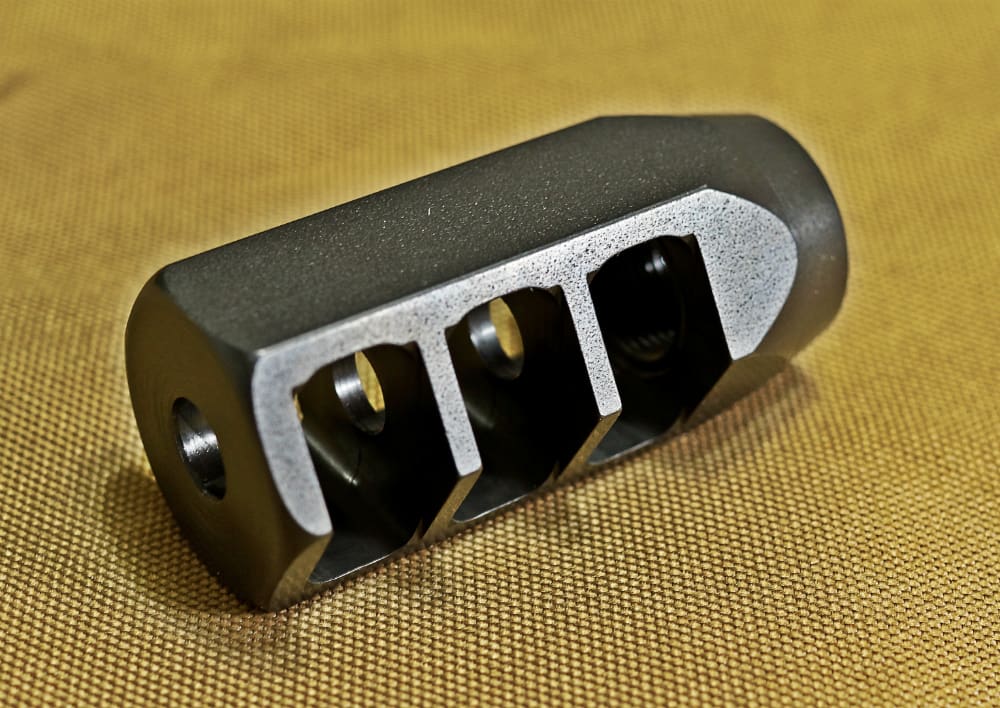
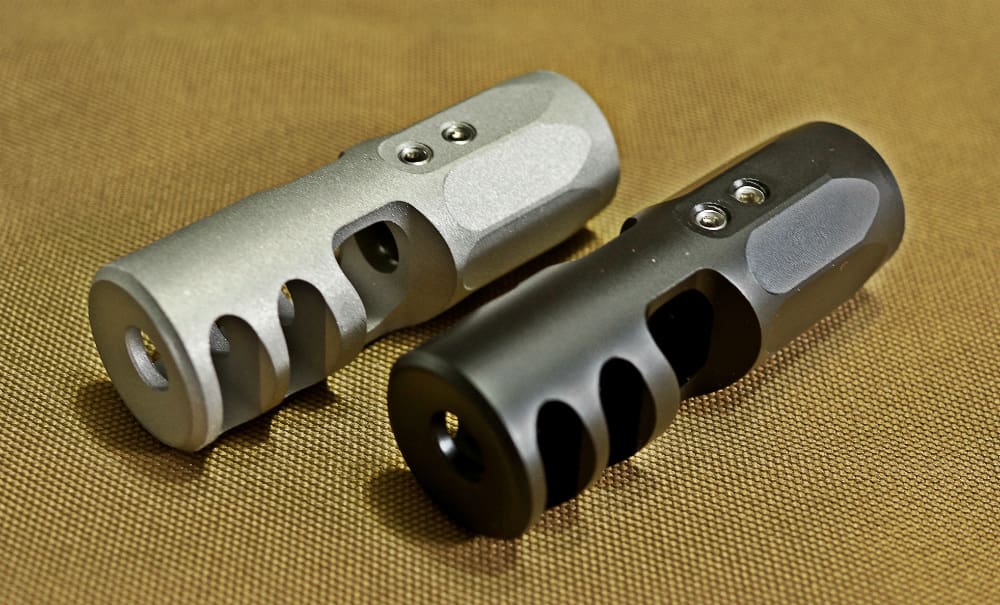
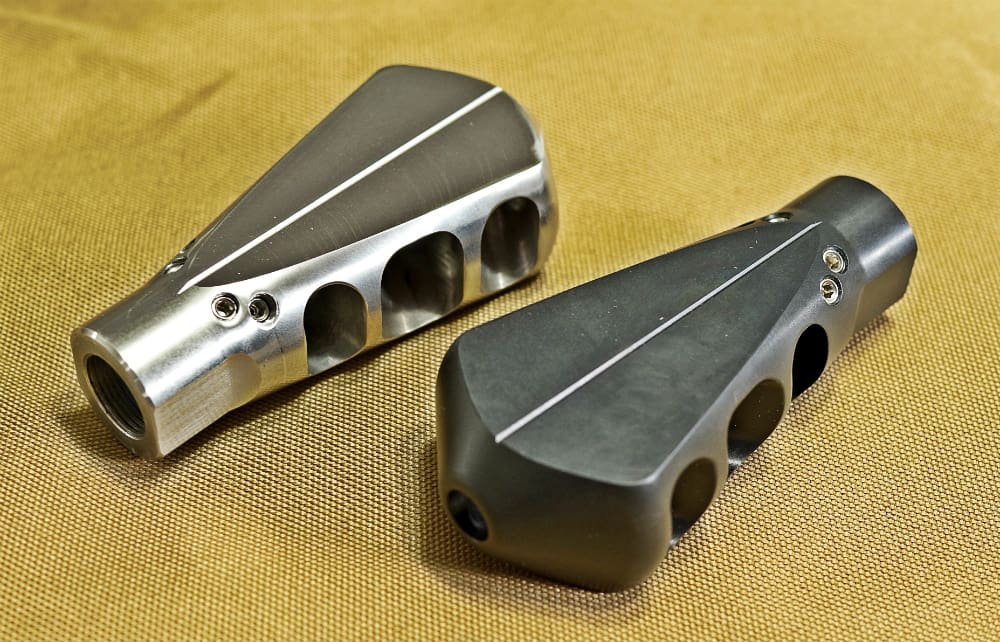
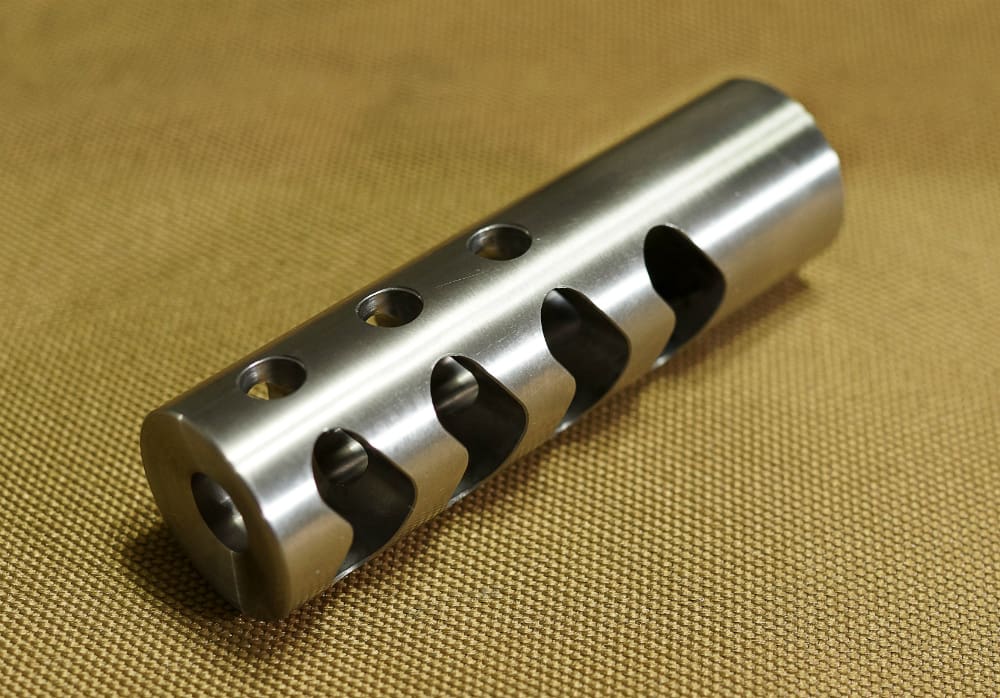
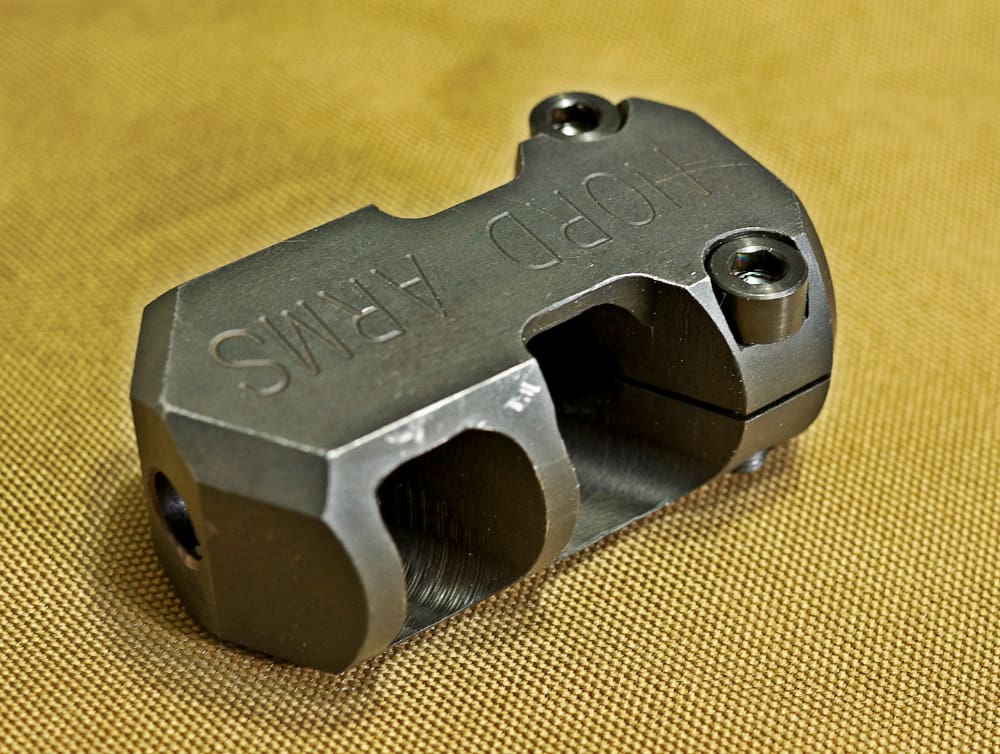
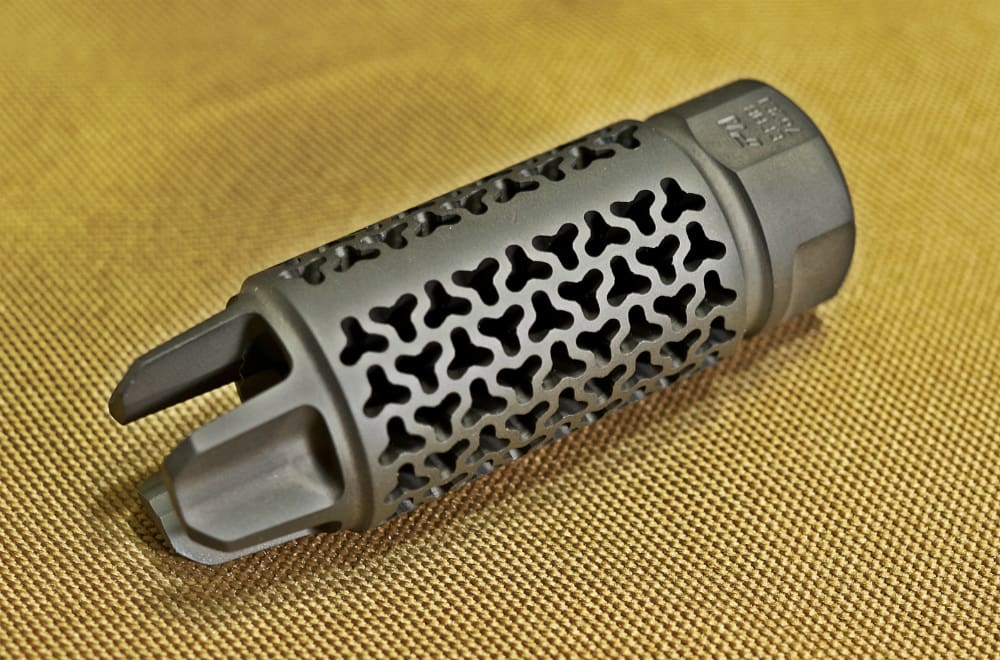
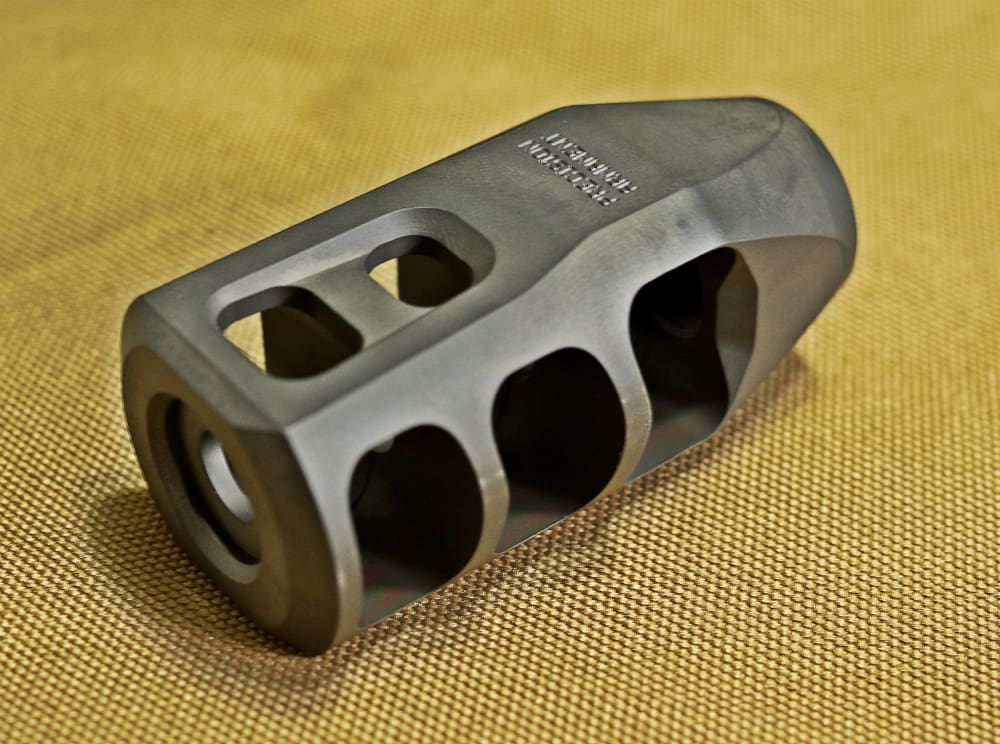
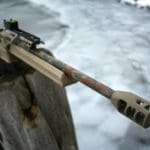
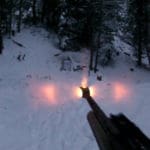

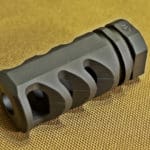
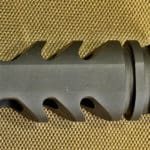

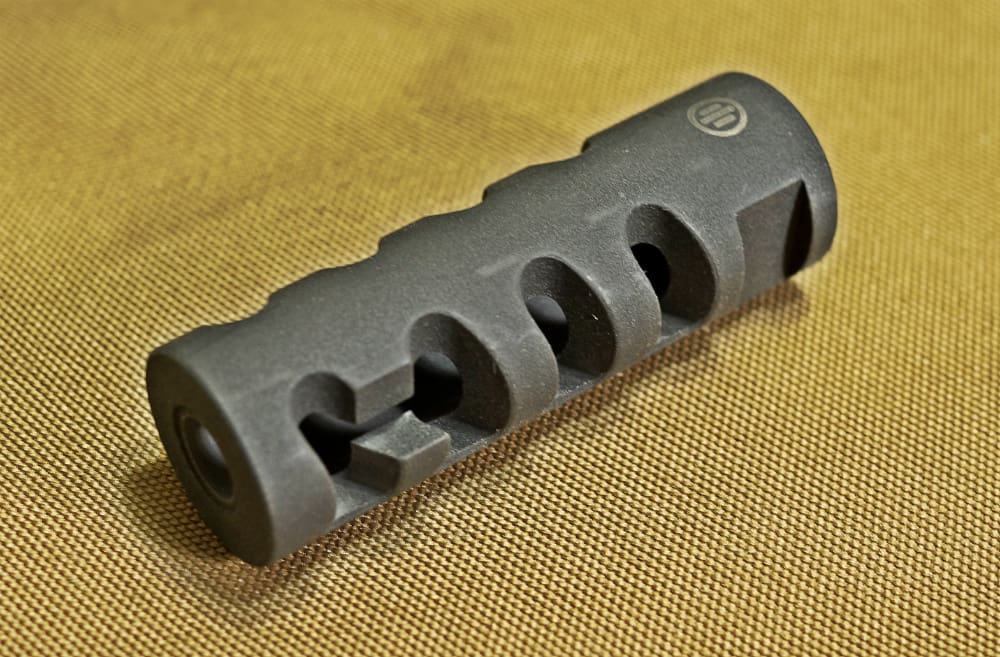
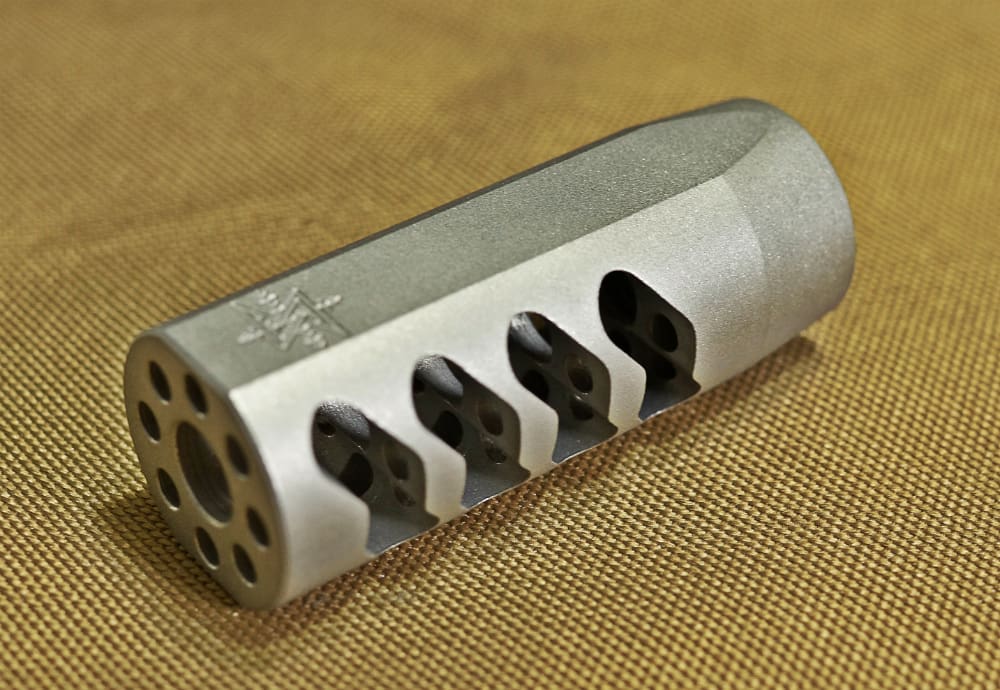
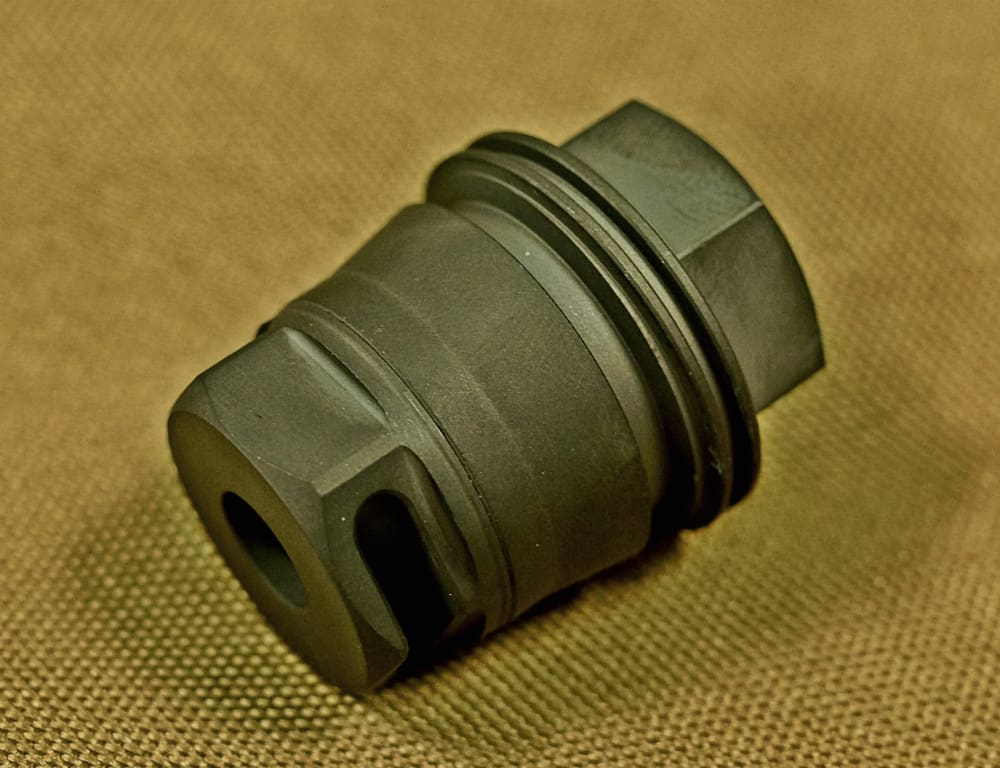
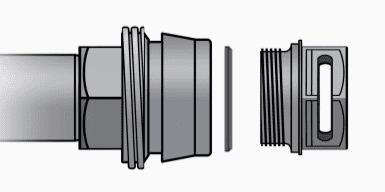
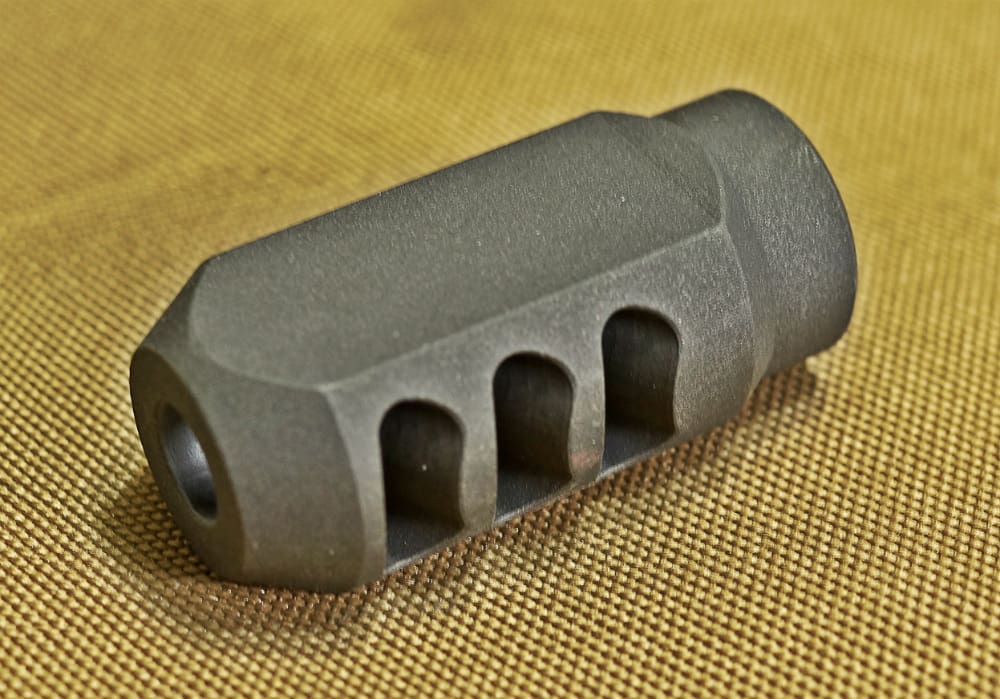
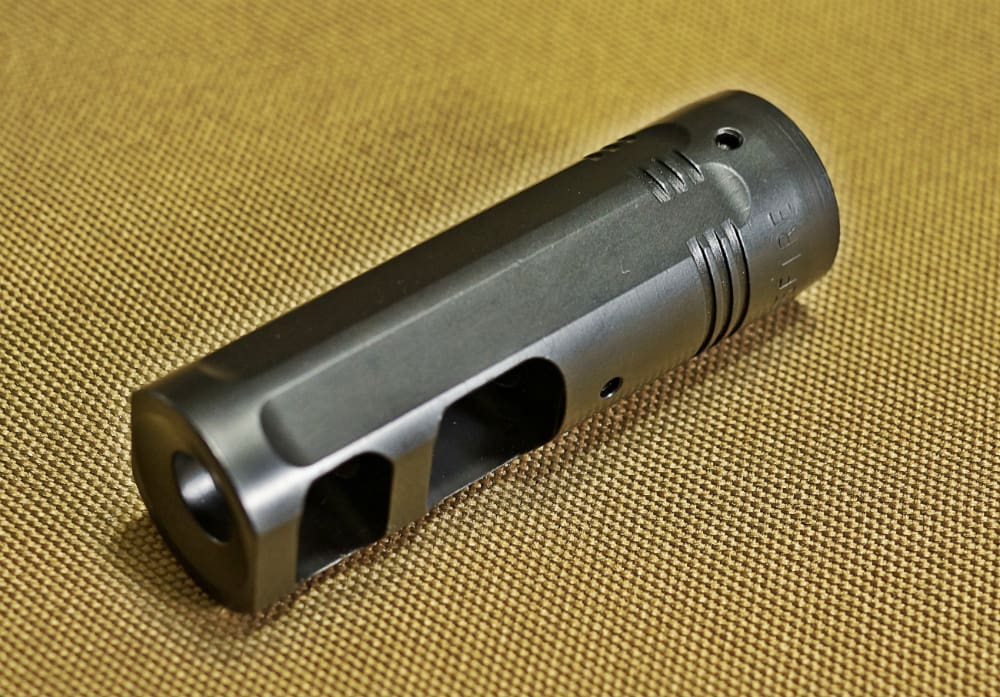

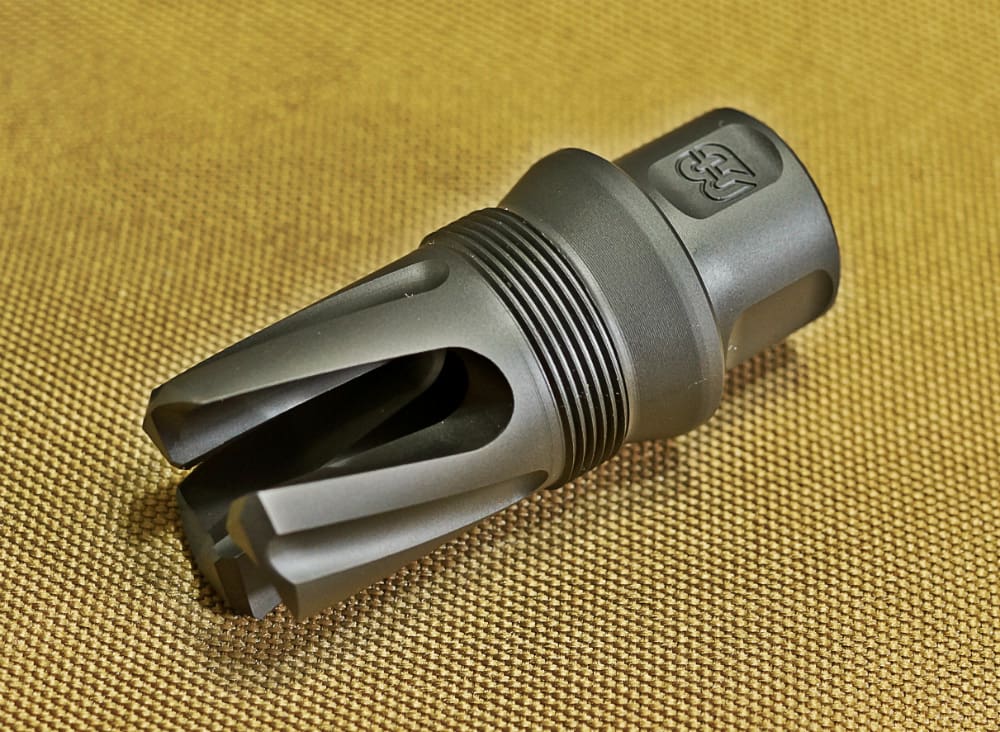
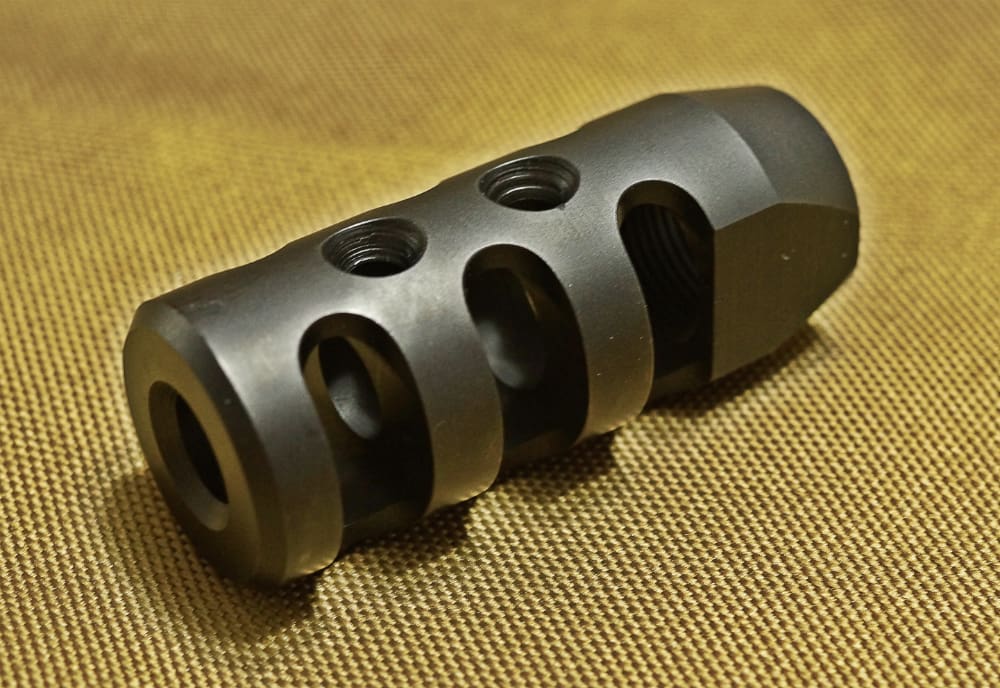



On the shopping list goes the m4-72
I put an M4-72 on a new Armalite upper AR-10 and tried to zero the rifle. Using a Shepard 3-10 scope that I had previously used on a National Match receiver. What I used was a Mil-Spec M-16/4 25 meter zeroing target set a 25 Meters after 25 rounds what I got was a group of Buck Shot. Afterward, I switched to Precision Arms M-11 and that fixed the problem. Point is the M4-72 muzzle brake softens the kick but screwed up the accuracy.
Currently My M&P 10 is a Shooter, however im having the same Short Stoking as many are. Going to drill out the Gas Port just a touch ( from .068 to .0781 or maybe even a little less ). However, im concerned weather or not that will affect accuracy, i hope not as it is an absolute shooter right now. I am considering the Wilson Combat Q Comp because it reduce flash to almost 0, and has some recoil and muzzle rise contributions. Recoil isnt bad to start with, so if it helps by 30% without the added Noise,
that would be great
Have the 5.56 m4-72 on a build with a sd3g trigger…fun times.
For some other very good reviews, precisionrifleblog.com did a few. They compared silencers and brakes for sound, muzzle blast and ground signature, recoil, poi shift and ability to stay on target. They also had an overview article and one outlining the methods used.
Also check out their articles comparing a bunch of high end scopes, with thorough performance testing.
Some of the best reviews on brakes and scopes I’ve read.
I’ve heard some of the competition shooters (5.56 guys) on Brian Enos forum complaining that the rearward blast on the M4-72 is severe, causing them issue, and a couple guys have changed them out.
How have you found the blast on the m4-72 when it’s shouldered and such?
Doesn’t bother me. I’ve even had it on my Tavor. I can usually feel some warm wind moving around me from it, but nothing much worse than that. It actually has less concussion than a lot of the brakes — that is, less of the thump you feel in your chest and sinuses that makes brakes annoying and “loud” to most bystanders and such — but it sends out a gust of wind for sure. For the shooter I don’t think it’s all that noticeable as it usually goes around you. For people in the immediate area they’re going to notice it. But again, it’s more of a gust of warm wind and less of a pressure wave concussion. On the Tavor I could definitely feel it on my left arm and such, but I don’t find it bothersome. Definitely I could see it mentally distracting people though if they focus on it.
BTW if any chunks of crap get shot out the ports, the shooter should be well behind that. On a shorter barrel you’re at the edges of the wind disturbance from it, and on a longer barrel (at least 16″ on a non-bullpup rifle) I don’t think you really notice much of anything unless you’re really looking for it or are really easily distracted 😛
EDIT: here, not sure how valuable this footage will be, but I remembered shooting it on camera for the MagnetoSpeed Chronograph review. This part has 10 shots rapid fire, and then if you go back to 7:40 into the video you can see it fired on the table so you can see how much the stuff around me moves from it. Mostly, just a paper towel that blows in the wind. https://youtu.be/v5IXXfuTCOc?t=9m50s
Midwest makes a 308 brake for $36 to your door and it works. I can’t say how much it works but I could not stand to shoot my AR10 without it.
So I’ve seen you do these tests before, and every time you include the AAC Brakeout, but you never include the AAC muzzle brakes that are just brakes and not combos. They have both a QD suppressor mount brake, as well as a non-mounting single chamber brake, but I’ve never seen them tested.
The very first test had the AAC Blackout 2-port brake in it (it’s the first one listed). The only non-mount ones I know of are flash hiders. Obviously I can’t get everything on the market. The interest in brakes that are QD mounts for specific silencers and cost way more than non-mount brakes is fairly low. If you don’t have the silencer in question it just isn’t something you’d generally consider buying, and if you do have the silencer in question you’re going to buy it no matter what. Brakeouts have been in these tests because I’ve happened to have them. In all cases the Brakeouts were loaned to me and I figured I may as well throw it in the test. The majority of the tested brakes were chosen more specifically due to demand and interest level, and some others also fell in my lap via loans from friends and whatnot.
If there’s a second .308 test, it will include the JP Recoil Eliminator, the Alamo Four Star Cowl Induction Brake, and the American Precision Arms Bastards, among others… but I won’t be seeking out any of the other AAC ones and won’t re-test the Brakeout. I’ll test an AAC one though if you want to loan it to me 😉
Oh good. The APA lil’b makes a 6.5 creedmoor LR308 into a complete pussycat of a shooter. I would expect it to end up right next to the m4-72.
It looks like they discontinued the non-mount single chamber brake. I’ll have to check your other test, because I remember seeing the Brakeout but not the pure brake.
Would love to see the M4-72 compared to the APA Little Bastard. That is the perennial favorite with precision rifle shooters.
I love the data sheet, can you add the measured concussion blast please?
“I’ve purchased air pressure sensors designed to log blast waves so we can compare the amount of concussion each muzzle device generates, and these will be used in test four.”
I’m looking forward to seeing the results from test 4. Thank you for posting such a detailed comparison.
I have a muzzle brake that removes ~70% of the rifles recoil and muzzle climb so that you can get the next shot on target. Here is a link to my Ebay listing. https://www.ebay.com/itm/183206710723?ssPageName=STRK:MESELX:IT&_trksid=p3984.m1558.l2649
Do some Griffin armament stuff!
Jeremy, when do you plan on doing the next 5.56 muzzle device video? I have 3 good ones I would love for you to test, and 2 more I want to hunt down.
1. Early style A1 duckbill from Manticore Arms – I remember you testing a later type one in some video, but can’t seem to find it. The later ones have a more closed off design to increase strength and eliminate the tuning fork sound at the cost of flash suppression.
2. Suarez V-76 – A repro of the 3 prong hider on the Valmet rifles, minus the bayonet lug
3. Armalite AR-18 duckbill – technically the 3rd and final generation of the Armalite 3 prong style flash hiders.
4. I would love to get my hands on and send you the HK 4 prongs they use on the G36
5. I would also like to try to get one of the 3 prongs Sig is using on the MCX (I believe the same one is on their 556i)
The second flash hiding test (http://www.thetruthaboutguns.com/2015/12/jeremy-s/ar-15-flash-hiding-test-2/) had a retro 3-prong and retro A1 FH in it. I’m not going to include these flash hiders in a muzzle brake test, though, as none of them have any design features intended to reduce recoil and they’ll all cluster within a few percent of the recoil of a bare muzzle. I’ll hit you up to borrow those and can definitely snag an MCX 3-prong if I do another flash hiding test, but I actually doubt that will happen. Interest in the FH tests proved to be extremely low compared to the brake tests. I’m not planning on doing a third.
People have been asking since Nov 2014 for Griffin’s stuff to be looked at and still no quantified testing for muzzle breaks. 3 of their flash hiders were looked for flash suppression at but not any of their 14 break or comp type devices for recoil. Is this Muzzle Brake Test #3 or is that still happening in the future?
The Hammer Comp will be in brake test #3 for 5.56. This test here is brake test #1 for .308. The 5.56 vs .308 brakes and FHs are not compatible at all, so it’s a completely separate group that I keep in a completely separate shoe box 😛
Anyway, I understand your frustration. But here’s the candid truth: I have basically no budget for this. I’m able to buy one or two brakes, and choose to spend that money on the absolute most-requested one(s) that I wasn’t able to borrow or get donated. Nearly every brake other than 1 or 2 in each test was loaned to me or donated. I’ll contact Griffin, tell them that there’s demand, and ask them to loan me some recoil-reducing designs for the next 5.56 brake test as well as the next .308 brake test. Demand hasn’t been high enough for me to actually buy them.
Anyone with contacts at any company that manufactures these sorts of things is more than welcome to pressure them to loan/donate one for future testing! Or just blast whatever e-mail address or phone number is on their website 😉 . If I have it, I’ll test it. Having it is the hard part. I have also borrowed some from TTAG readers in the past. Only catch there is that I usually end up hanging onto it for a couple weeks before it gets mailed back. Manufacturers can contact me via e-mail at GunsAndGearEJ20 followed by that @ symbol followed by gmail.com
Why wasn’t the JP Recoil Eliminator included? It was tested previously and they do make a .308 version. If I recall correctly it had the top score on the least movement off target between shots which is as important if not more important than pure recoil reduction.
There are probably 1,000 brakes that didn’t make it into this test, with the main reason for that being I didn’t have them. More details in some of my previous comments.
Looks good Jeremy! Thanks!
-Adam Lilja
In addition to the ones you plan on adding to the 2nd .308 brake test…if you can get a hold of them, I’d recommend:
JEC
Kelby Ported Muzzle Brake
Muzzle Brakes and More “Beast”
DPMS Miculek
Lund / SJC Titan
SilencerCo Specwar
So based on these tests, if design works well for 5.56 and that same design is available for the larger 308/7.62, then it would likely have similar recoil reduction abilities? I ask because the Thunder Technologies Heartbrake did very well on the 5.56 tests and they do offer the brake in 7.62 also.
I think that’s fair to say. The recoil forces come from the same things and the recoil reduction comes from the same things. The .30 cal brakes don’t work quite as well, though, in terms of recoil reduction percentage because the larger bore diameter means more gas leaves the muzzle. Easier to “catch” and deflect a higher percentage of the gases with a smaller bore.
I noticed you didn’t put the Ruger Muzzle Break that comes standard on the African addition as well as a few other models and is one of the best I have ever shot. I would love to see where it falls in your professional test conditions!!
http://shopruger.com/30-Caliber-Muzzle-Brake-Stainless-Steel/productinfo/90468/
I haven’t found any with holes like that to be particularly effective in pure recoil reduction. I’d certainly test it if I did another .30 cal test (which I’m not sure I’ll do), but your link says it has 1/2-28 threads and that’s a big issue. That’s the typical thread pattern for a .223, and every .308 or other .30 cal (other than foreign-made AK) I’ve come across is threaded 5/8-24. The brake wouldn’t fit on any of the test guns I’d be using.
Hi Jeremy,
Here’s another .30 caliber hybrid muzzle brake by Ruger. My guess is they are trying to tame their popular RARR in 7.62×39. Thoughts on how this might stack up?
RUGER HYBRID MUZZLE BRAKE 5/8X24
https://grabagun.com/ruger-hybrid-muzzle-break.html
VERY, VERY, VERY late to the party but, here’s the one for the .308…
https://shopruger.com/Muzzle-Brake-308-Caliber-5_8-24/productinfo/90602/
If you’re looking for work, why not test pistol brakes (although I’d guess linear comps might be more important to police).
True, it’s easy for commenters to spend your time and money. Maybe you could try crowd funding?
Cheers
http://precisionrifleblog.com/2015/08/07/muzzle-brakes-sound-test/
I wonder how the Precision Armament M41 would fare on this chart. Anyone see reports or stats on it?
Would the M4-72 (or another) work on a Remington 700 BDL in 30-06? I do know someone capable of treading the barrel.
Yeah, as long as the barrel is thick enough to provide a shoulder for the brake once threaded, any of these should work on it for that caliber.
Love the video and write up. If you were to do another, and were taking suggestions of what to test next, I would throw the Cadex MX-1 in the ring. It is very similar in appearance to the Lancer Systems Viper.
Here, have a link: http://www.cadexdefence.com/products/weapon-accessories/muzzle-brakes/
That’s cool looking. Holy crap $269 is a lot though.
Yeah, it is a wad of cash, but Christmas gift cards and all… Unfortunately I live in the Middle of no place, so the local gun shop only had 4 to pick from, but they seem to only bring in the best. I actually tried it out for the first time today and it worked really well. Minimal felt recoil and almost no muzzle jump. Keep up the good work Jeremy.
Do you have any more information on the Nord 308 open. I really like the look, performance and price point. However, it doesn’t look like it has hit the US market yet. Thanks
They were at Brownells very briefly then back off. I’m not sure what’s up. They do sell directly, though, even to the U.S.: http://www.nordarms.com/directly-from-us.html
I have found the Ares Armor “Effin-A” comp to be superior at eliminating muzzle rise.
It’s a TUNABLE comp with threaded ports that YOU decide how you want your ports to be, and how many.
Ever heard of it Jeremy?
With this thing (I have the 5.56 and .30 cal versions) my muzzle doesn’t rise at all, only dips a bit, making rapid-fire on target a dream.
I’d love to hear your opinion of that one!
10% less reduction for 1/2 the cost? That sounds like a winner to me when you’re talking about .308. It’s not like we’re trying to tame a 416 Rigby or something.
No Levang-style Linear Comps included in this round-up? Wish they included them — they are a great alternative to the traditional muzzle break … great at dispersing sound out and away, your range-mates will appreciate it. Also reduces recoil a bit, but the trade off is most linear comps don’t do much to hide muzzle flash.
For me, reducing noise, muzzle lift, and recoil is more important than muzzle flash – besides, the kids love the muzzle-flash after it gets dark, lol.
If you are looking more to reduce muzzle jump and noise, consider a linear comp, especially for 308 – some mfg’s include KAW, BRT, DPMS, etc.
Here’s an example:
http://www.joeboboutfitters.com/Kaw_Valley_Precision_30cal_Linear_Comp_5_8x24_Blac_p/kvp-linear308-blk.htm
The next time you do a Brake review, you have got to try the Terminator Line from Australia! I have the M4-72 on my AR-15 and it kicks A$$. I got the Terminator T-3 for my .308 and oh my it’s an M4-72 on Steroids! I think the T-2 is equivalent to the M4-72 only a little better at braking.
http://terminatorproducts.co.nz/brakes/
Those look identical to the ‘bastard’ series from American Precision Arms. I wonder if they’ve licensed the design or are white labeling the APA ones or whatever (or maybe it’s the reverse?). We do intend to include a couple APAs in the next test…
They are there own design, you’ll notice they have 5 vents on each side. I sent them a message telling them about your upcoming reviews, maybe they will send some goodies to test. Keep up the great work an your reviews!!!
based on the 5.56 review, i bought the m11 brake for my .308, hoping it would perform just as well as the smaller version and it does, besides i just love the look of it.
however, i’m missing the miculek MIC-COMP-30 brake in your review.
the MIC-COMP-223 performed very well in the first shootout but the design of the .223 and the .30 versions are not identical.
Have you reviewed the VG6 Precision Gamma 762? If so, how does it compare to the others listed?
Yes. Would like to see the VG6 Epsilon 762 and the new Vg6 Lambda PRS30 thrown into the next round.
I just bought a Thompson Center Compass in .308 for hunting that comes threaded which is cool. Unfortunately cant have an evil “Silencer” as an Illinois resident, but I’m wanting to screw something onto the end of the barrel to keep the muzzle down so I can spot my shots better. I rifle hunt in WI from an enclosed shack… shooting out a window/ hatch.
Blast doesn’t bother me. I Usually have a guy next to me in the shack, but it’s one shot once a year so he can deal with the concussion. BUT… you have the range queens who whine, so I’m looking for something a little less concussive. I also want a brake that wont throw dirt into my face when shooting prone.
Is there a comp worth screwing on that isn’t so concussive? I see these comps with forward facing ports, but am skeptical.
Thanks!
It is interesting that in your data Nord Arms OPEN 308 had the lowest recorded recoil at 6.3750 vs 6.4375 for the Precision Armament M4-72, yet without any further testing you named the M4-72 as the winner. I see you recorded that the OPEN 308 recoiled 6.7500 in the first test then 6.3750 in the second, and that the first test is what brought the average recoil higher than the M4-72. Why do you think there is such a relatively large difference between test one and test two for the Nord Arms OPEN 308? And being that the OPEN 308 is the runner up and was recorded with a lower recoil, don’t you think further testing would be required to definitely say the M4-72 recoils on average 0.51% less than the OPEN 308? I know I’m nitpicking here, just curious as to what your thoughts on this are. To be honest, I would have liked to seen you do a few more tests on only the top five to reduce the effect of outliers on the average. Thanks for the review!
While we are at it, I’d like to see the Ares Armor “Effin-A” tested without the holes all OPEN. Realistically, they’re meant to be partially closed, or what’s the point?
Of course, I’m interested in this one because it’s the one I personally use on my 5.56 and .308 rifles.
I’ve found that by plugging certain holes and leaving others open, I can almost entirely remove the “up and to the right” muzzle flip that is common to the AR platform. Even in rapid-fire, I get only a slight dip, allowing quicker realignment of sights.
I’m not sure how this specifically equates to recoil reduction, but isn’t realignment of sights for the next shot really the purpose of mitigating recoil for either of these calibers (at least in a semi-auto rifle)?
man i plug to many holes on my EFFIN the first time and it pushed my rifle down so far I had to stop and let my brain catch up to what just happened lol
Took a few minutes, did it?
LOL
You should have tested a few of the popular generic ones you find on eBay for $15-$20 to see how they compare
I am with Keith Harter. I am trying to figure out what brake to use on a new 6.5 Creedmoor. I would like to see a comparison between the Terminator T-3 brake vs. Alamo 4 Star / ZRODelta Cowl Induction Brake vs. Precision Armament M4-72 Brake.
Don’t mind spending money for quality. Just doesn’t seem like anyone has compared these three side-by-side.
Will Truth About Guns do a follow-up?
If you play around with the momentum and motion equations, you can approximate the recoil reduction provided by the brake from your measurements. The reduction in axial momentum on the gun (recoil reduction) with respect to the bullet momentum is crudely approximately by [1-sqrt(1-R)] where R is the reduction in displacement that you tabulated. Most of the brakes examined are in the 25% – 40% range.
I would like to know how a .30 cal SJC Titan Comp does the against the .30 cal Precision Armament M4-72 Severe-Duty Compensator. Since it now reigns as champ in the AR-15 muzzle brake shootout #3 test.
I have a muzzle brake that removes ~70% of a rifles recoil.
Jeremy, Here is a picture of my muzzle brake. Please let me know if you would like to test it.
https://www.ebay.com/itm/183159734059?ssPageName=STRK:MESELX:IT&_trksid=p3984.m1558.l2649
Your link is broken.
It’s nordarms.com NOT nord-arms.com!
Do you have the corresponding DB levels for each.
Best brake at the lowest DB level.
Thank you.
Hey Jeremy,
I’m curious why the Vais Muzzle Brake didn’t get tested. They’ve been around for over 30 years and were even featured on the Brownell’s cover back in the late ’80s- early ’90s.
Regards
How do you run a brake test without APA, one of the best selling most popular brakes? The Fat B and Little B should be #25.
One thing nobody comments about is how does the Precision Armament M4-72 reduce recoil in the real world? Well, I’ll tell you, Shooting an M118 duplication load feels like a pleasant 22 RF, and I can shoot that all day long.
I installed a Cherry Bomb on my 300 blackout. The threads are much finer. I thought I cross threaded. I send it back and manufacture retapped it like new. Meanwhile I got a 5.56 can and from manufacturer I bought what they called “Three Leg Jack” threaded muzzle. The threads are corser and fits.
1. Is there a threaded muzzle out their in 7.62 with corse threads?
2. Or with tapered Cherry Bomb wrench it on and leave it?
3. Or get another Three Leg Jack that fits my can and have gunsmith drill from 5.56 to 7.62?
I would be forever Grateful if you could include the Wilson Combat Q Comp for .308 in your test. Or, even if you could just test it separately as you already have the conclusions from these comps. Its reported that it had almost 0 flash and for that reason im concerned about its ability to handle muzzle rise and recoil. It is also reported that it has excellent muzzle rise and rear recoil reduction, without the NOISE. Please Consider if you can, thks Nathan
I don’t foresee testing that one (it’s unlikely that there will be another .30 cal test), but from its design I’d expect something in the range of a 30% reduction in recoil and it will most definitely apply downward pressure on the muzzle.
Thank you for the quick response ! Appreciate your advice, take care
Any thoughts on doing another .30cal test as this one is almost 4 years old and there are a lot of new and highly touted muzzle brakes out there. Two that I can think of off of the top of my head SJC Titan and the CODA .308 Fury Titanium.
One of the problems in using some of the MBs is a lack of accuracy, please include this with the results
I’d love to see the Troy Medieval Muzzle brake tested. It would be nice to see some quantified data on how it performs, as I have one on my AR-10. The first flash hider test included that version for the AR-15; seems like including the brake version of either the 5.56 or 7.62 would follow.
This blog is good I have it a 5star rating yall doing a great job keep it up guys your content is so lovely
I like how you mentioned that it is important that machining is made up totally clean. My uncle mentioned to me last night that he is planning to buy a carbon steel muzzle brake as a gift for himself but he’s not yet sure where to buy it. Thanks to this informative article and I’ll be sure to tell him that it will be much better if he consults a trusted kit, cups, and parts dealer as they can answer all his inquiries.
https://shootarillusions.com/product/cheap-6-5-creedmoor-500-rounds/
ダッチワイフ 高級 あなたのダッチワイフを適切にドレスアップする方法2021年の最高のオンラインダッチワイフストアあなたのダッチワイフと一緒に行くための基本的なヒントどのようにあなたは古いダッチワイフを捨てますか?
This is the best blog so far keep it up
最安値直販店ラブドール通販店 | ブランド正規品 |おとなLOVE (otona love) は正規直販店であり、自分の生産現場を持っております。第三者に通らず生産現場から直接顧客に配送するため、TPE素材や高級シリコン製のラブドールを低価格高品質で入手できます。また、正規代理WMDOLLラブドール、6YEDOLLラブドール、JY DOLLラブドール、メーカーから直接消費者の手元に届くようなサービスを提供させていただきます。品質保証、安心・安全への取り組み。
This is really interesting, You are a very skilled blogger. I have joined your feed and look forward to seeking more of your magnificent post. Also, I ave shared your web site in my social networks! Benefit of Portable Power Station
Please spread more talcum powderラブドール on the place where the human body rubs with the doll, which can not only reduce friction but also avoid the inconvenience of cleaning the doll caused by dirt on the human body.
After all, some people like tall, inflatable dolls, but they have no advantages. Why? Since the physical doll needs to be made, ラブドールit is difficult to use it without sufficient physical strength. I like Laurie’s style and serious face.
This is the best blog so far keep it up
I like how you mentioned that it is important that machining is made up totally clean. My uncle mentioned to me last night that he is planning to buy a carbon steel muzzle brake as a gift for himself but he’s not yet sure where to buy it. Thanks to this informative article and I’ll be sure to tell him that it will be much better if he consults a trusted kit, cups, and parts dealer as they can answer all his inquiries.
I really enjoyed browsing your website. I’ve already suggested it to some of my closest family members. The Site is fantastic and I’ll keep I’ll recommend it to all my acquaintances.
This blog is good I have it a 5star rating yall doing a great job keep it up guys your content is so lovely
I would like to know how a .30 cal SJC Titan Comp does the against the .30 cal Precision Armament M4-72 Se완도출장샵vere-Duty Compensator
CNC Torna
Comments are closed.